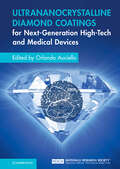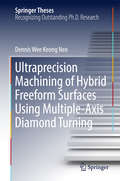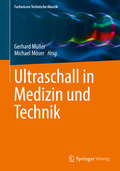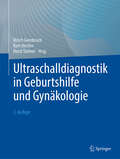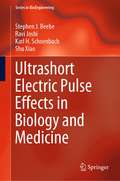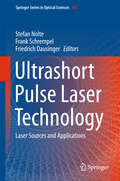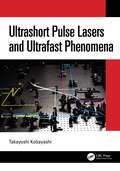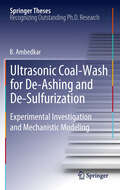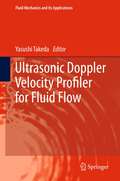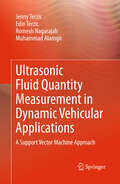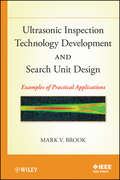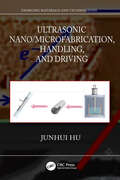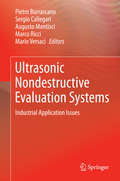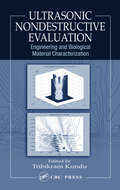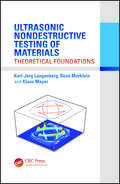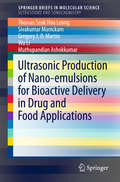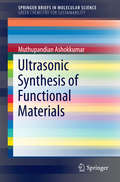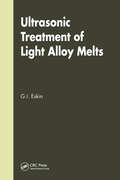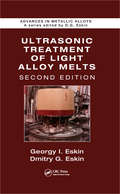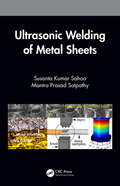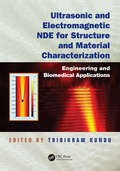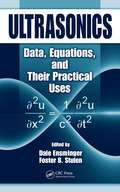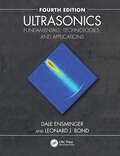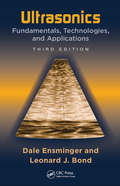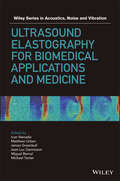- Table View
- List View
Ultrananocrystalline Diamond Coatings for Next-Generation High-Tech and Medical Devices
by Orlando AucielloA comprehensive guide to the science of a transformational ultrananocrystalline-diamond (UNCDTM) thin film technology enabling a new generation of high-tech and external and implantable medical devices. Edited and co-authored by a co-originator and pioneer in the field, it describes the synthesis and material properties of UNCDTM coatings and multifunctional oxide/nitride thin films and nanoparticles, and how these technologies can be integrated into the development of implantable and external medical devices and treatments of human biological conditions. Bringing together contributions from experts around the world, it covers a range of clinical applications, including ocular implants, glaucoma treatment devices, implantable prostheses, scaffolds for stem cell growth and differentiation, Li-ion batteries for defibrillators and pacemakers, and drug delivery and sensor devices. Technology transfer and regulatory issues are also covered. This is essential reading for researchers, engineers and practitioners in the field of high-tech and medical device technologies across materials science and biomedical engineering.
Ultraprecision Machining of Hybrid Freeform Surfaces Using Multiple-Axis Diamond Turning
by Dennis Wee NeoThis thesis focuses on producing hybrid freeform surfaces using an advanced diamond-turning process, understanding the generation of surface accuracies (form errors) and how the choice of cutting strategies affects these, as well as simplifying the complications of generating cutting paths for such freeform surfaces. The breakthroughs behind this thesis are the development of novel, multiple-axis, diamond turning techniques to overcome the limitations of conventional diamond turning processes, an analytical model to optimize the generation of ultraprecise freeform surfaces, and an add-on tool path processor for CAD/CAM software solutions. It appeals to researchers and scholars with a strong machining background who are interested in the field of manufacturing ultraprecise freeform surfaces or in the field of optimizing ultraprecision machining processes.
Ultraschall in Medizin und Technik (Fachwissen Technische Akustik)
by Michael Möser Gerhard MüllerDieser Band der Reihe Fachwissen Technische Akustik erläutert die technischen Grundlagen und Besonderheiten des Ultraschalls. Der Autor befasst sich mit der Erzeugung und Messung von Ultraschall und den Eigenschaften des Schallfeldes. In einem zweiten Teil werden einige wichtige Anwendungen von Ultraschall in Medizin und Technik dargestellt.
Ultraschalldiagnostik in Geburtshilfe und Gynäkologie
by Ulrich Gembruch Kurt Hecher Horst SteinerDieses Standardwerk der pränatalen, geburtshilflichen und gynäkologischen Sonographie ist äußerst hilfreich für die Weiterbildung und Fortbildung in der Geburtshilfe und Gynäkologie. Sie erfahren alles über die Abläufe sonographischer Untersuchungen und den dabei nutzbaren Techniken, wie B-mode, Doppler- und Farbdoppler, 3D- und 4D-Volumensonographie, M-mode, Speckle Tracking, Gewebedoppler und Kontrastmittelsonographie sowie über ihren jeweiligen Einsatz bei der Diagnostik fetaler Erkrankungen und Anomalien und in Geburtshilfe, Gynäkologie und Reproduktionsmedizin.Herausgeber und Autoren teilen mit diesem Werk ihre jahrzehntelange Erfahrung und publizieren ein sehr umfangreiches Nachschlagewerk für das optimale klinische Vorgehen in üblichen wie schwierigen Situationen mit über 1500 exzellenten Bildern. Die 3. Auflage erscheint komplett auf den neuesten Stand der klinischen Forschung aktualisiert und mit neuen Themen, wie der Einsatz von künstlicher Intelligenz unddie intrauterine Chirurgie
Ultrashort Electric Pulse Effects in Biology and Medicine (Series in BioEngineering)
by Stephen J. Beebe Ravi Joshi Karl H. Schoenbach Shu XiaoThis book presents an overview of the current state of research on ultrashort electric field pulses of high intensity and their use in biology and medicine. It examines in detail the most recent and exciting advances in how nanosecond and picosecond electric pulse research has grown and expanded into new areas of biology and medicine. Further, the book specifically focuses on electric pulses in the time domain, on intracellular effects as opposed to plasma membrane electroporation, and highlights the biological and medical applications of these unique pulse effects. Since the authors were initial innovators exploring nanosecond and picosecond pulses, their unique perspectives foreshadowed directions the research took, expanding into new areas that they continue to investigate today.
Ultrashort Pulse Laser Technology
by Stefan Nolte Frank Schrempel Friedrich DausingerUltrashort laser pulses with durations in the femtosecond range up to a few picoseconds provide a unique method for precise materials processing or medical applications. Paired with the recent developments in ultrashort pulse lasers, this technology is finding its way into various application fields. The book gives a comprehensive overview of the principles and applications of ultrashort pulse lasers, especially applied to medicine and production technology. Recent advances in laser technology are discussed in detail. This covers the development of reliable and cheap low power laser sources as well as high average power ultrashort pulse lasers for large scale manufacturing. The fundamentals of laser-matter-interaction as well as processing strategies and the required system technology are discussed for these laser sources with respect to precise materials processing. Finally, different applications within medicine, measurement technology or materials processing are highlighted.
Ultrashort Pulse Lasers and Ultrafast Phenomena
by Takayoshi KobayashiThis book describes the basic physical principles of techniques to generate and ultrashort pulse lasers and applications to ultrafast spectroscopy of various materials covering chemical molecular compounds, solid-state materials, exotic novel materials including topological materials, biological molecules and bio- and synthetic polymers. It introduces non-linear optics which provides the basics of generation and measurement of pulses and application examples of ultrafast spectroscopy to solid state physics. Also it provide not only material properties but also material processing procedures. The book describes also details of the world shortest visible laser and DUV lasers developed by the author’s group. It is composed of the following 12 Sections: The special features of this book is that it is written by a single author with a few collaborators in a systematic way. Hence it provides a comprehensive and systematic description of the research field of ultrashort pulse lasers and ultrafast spectroscopy. Generation of ultrashort pulses in deep ultraviolet to near infrared Generation of ultrashort pulses in terahertz Carrier envelope phase (CEP) Simple NLO processes with a few colors Multi-color involved NLO processes Multi-color ultrashort pulse generation NLO materials NLO processes in time-resolved spectroscopy Low dimension materials Conductors and superconductors Chemical reactions and material processing Photobiological reactions
Ultrasonic Coal-Wash for De-Ashing and De-Sulfurization
by B. AmbedkarThis study focuses on the physical aspects of ultrasonic de-ashing and de-sulfurization, such as cavitation, streaming and their combined effects. Ambedkar Balraj proposes an ultrasound-assisted coal particle breakage mechanism and explores aqueous and solvent-based ultrasonic techniques for de-ashing and de-sulfurization. Ambedkar designs a Taguchi L-27 fractional-factorial matrix to assess the individual effects of key process variables. In this volume he also describes process optimization and scale-up strategies. The author provides a mechanism-based model for ultrasonic reagent-based coal de-sulfurization, proposes a flow diagram for ultrasonic methods of high-throughput coal-wash and discusses the benefits of ultrasonic coal-wash. Coal will continue to be a major fuel source for the foreseeable future and this study helps improve its use by minimising ash and sulfur impurities.
Ultrasonic Doppler Velocity Profiler for Fluid Flow
by Yasushi TakedaThe ultrasonic velocity profile (UVP) method, first developed in medical engineering, is now widely used in clinical settings. The fluid mechanical basis of UVP was established in investigations by the author and his colleagues with work demonstrating that UVP is a powerful new tool in experimental fluid mechanics. There are diverse examples, ranging from problems in fundamental fluid dynamics to applied problems in mechanical, chemical, nuclear, and environmental engineering. In all these problems, the methodological principle in fluid mechanics was converted from point measurements to spatio-temporal measurements along a line. This book is the first monograph on UVP that offers comprehensive information about the method, its principles, its practice, and applied examples, and which serves both current and new users. Current users can confirm that their application configurations are correct, which will help them to improve the configurations so as to make them more efficient and effective. New users will become familiar with the method, to design applications on a physically correct basis for performing measurements accurately. Additionally, the appendix provides necessary practical information, such as acoustic properties.
Ultrasonic Fluid Quantity Measurement in Dynamic Vehicular Applications
by Edin Terzic Romesh Nagarajah Muhammad Alamgir Jenny TerzicAccurate fluid level measurement in dynamic environments can be assessed using a Support Vector Machine (SVM) approach. SVM is a supervised learning model that analyzes and recognizes patterns. It is a signal classification technique which has far greater accuracy than conventional signal averaging methods. Ultrasonic Fluid Quantity Measurement in Dynamic Vehicular Applications: A Support Vector Machine Approach describes the research and development of a fluid level measurement system for dynamic environments. The measurement system is based on a single ultrasonic sensor. A Support Vector Machines (SVM) based signal characterization and processing system has been developed to compensate for the effects of slosh and temperature variation in fluid level measurement systems used in dynamic environments including automotive applications. It has been demonstrated that a simple ν-SVM model with Radial Basis Function (RBF) Kernel with the inclusion of a Moving Median filter could be used to achieve the high levels of accuracy required for fluid level measurement in dynamic environments. Aimed toward graduate and postgraduate students, researchers, and engineers studying applications of artificial intelligence, readers will learn about a measurement system that is based on a single ultrasonic sensor which can achieve the high levels of accuracy required for fluid level measurement in dynamic environments.
Ultrasonic Inspection Technology Development and Search Unit Design Examples of Practical Applications
by Mark V. BrookUltrasonic testing is a relatively new branch of science and industry. The development of ultrasonic testing started in the late 1920s. At the beginning, the fundamentals of this method were borrowed from basic physics, geometrical and wave optics, acoustics and seismology. Later it became clear that some of these theories and calculation methods could not always explain the phenomena observed in many specific cases of ultrasonic testing. Without knowing the nuances of the ultrasonic wave propagation in the test object it is impossible to design effective inspection technique and search units for it realization. This book clarifies the theoretical differences of ultrasonics from the other wave propagation theories presenting both basics of physics in the wave propagation, elementary mathematic and advanced practical applications. Almost every specific technique presented in this book is proofed by actual experimental data and examples of calculations.
Ultrasonic Nano/Microfabrication, Handling, and Driving (Emerging Materials and Technologies)
by Junhui HuUltrasonic nano/microfabrication, handling and driving is an emerging actuation technology, which utilizes ultrasonic vibration and the physical effects of ultrasonic vibration in fluids and solids to implement the fabrication, handling and driving of nano/micro scale objects. This book provides readers with the fundamentals, principles and characteristics of the ultrasonic devices for nano/micro fabrication, handling and driving, and design methods of the devices. • Introduces fundamental concepts and offers examples of ultrasonic nano fabrication, including ultrasonic nano rolling, cutting and coating methods. • Features a wealth of examples to illustrate the ultrasonic concentration and ultrasonic tweezers. • Explains the principles of ultrasonic driving of gas molecules and demonstrates their applications in high-performance gas sensor systems and metal-air flow batteries. • Teaches the principles of ultrasonic driving of microfluids and their applications in metal-air flow batteries and cooling of small solid heat sources. • Provides examples for the finite element method (FEM) modeling and computation of ultrasonic devices for nano/micro fabrication, handling and driving. • Summarizes the current and future trends in ultrasonic nano/microfabrication, handling, and driving. This book shares the advances, methods and applications of ultrasonic micro/nano fabrication techniques for entry-level and advanced readers working on nano/microfabrication, gas sensing, biological sensing, metal-air batteries, electronic component cooling, and other related areas.
Ultrasonic Nondestructive Evaluation Systems
by Pietro Burrascano Sergio Callegari Augusto Montisci Marco Ricci Mario VersaciThis book deals with a number of fundamental issues related to the practical implementation of ultrasonic NDT techniques in an industrial environment. The book discusses advanced academic research results and their application to industrial procedures. The text covers the choice and generation of the signals energizing the system to probe position optimization, from quality assessment evaluation to tomographic inversion. With a focus to deepen a number of fundamental aspects involved in the specific objective of designing and developing an ultrasonic imaging system for nondestructive testing, aimed to automatically classify the entire production of an industrial production line, targeted to the field of precision mechanics. The contents of this book is the result of the common effort of six University Research Groups that focused their research activities for two years on this specific objective, working in direct conjunction with primary industrial firms, in a research project funded by the Italian government as a Strategic Research Project.
Ultrasonic Nondestructive Evaluation: Engineering and Biological Material Characterization
by Tribikram KunduMost books on ultrasonic nondestructive evaluation (NDE) focus either on its theoretical background or on advanced applications. Furthermore, information on the most current applications, such as guided wave techniques and acoustic microscopy, is scattered throughout various conference proceedings and journals. No one book has integrated these aspe
Ultrasonic Nondestructive Testing of Materials: Theoretical Foundations
by Klaus Mayer Karl-Jörg Langenberg René MarkleinUltrasonic Nondestructive Testing of Materials: Theoretical Foundations explores the mathematical foundations and emerging applications of this testing process, which is based on elastic wave propagation in isotropic and anisotropic solids. In covering ultrasonic nondestructive testing methods, the book emphasizes the engineering point of view, yet
Ultrasonic Production of Nano-emulsions for Bioactive Delivery in Drug and Food Applications (Springerbriefs In Molecular Science: Chemistry of Foods)
by Muthupandian Ashokkumar Sivakumar Manickam Wu Li Thomas Seak Leong Gregory J. MartinThis SpringerBrief provides an overview of ultrasonic emulsification and an update on recent advances in developing stable emulsions for the creation of novel drugs and functional foods, with a focus on bioactive delivery in these products.Emulsification is the process of combining two or more immiscible liquids to form a semi-stable mixture. These two liquids generally consist of an organic (oil) phase and an aqueous (water) phase that is stabilized by the addition of an emulsifier. Most common emulsions are of the oil-in-water (O/W) type, but can also be of water-in-oil (W/O) or even multiple emulsion types (i.e. double emulsions) in the form of water-in-oil-in-water (W/O/W) or oil-in-water-in-oil (O/W/O) phases. The formation of an emulsion requires input of energy to distribute the disperse phase in the continuous phase in small-sized droplets that are able to resist instability. There is great interest in the use of ultrasound to produce emulsions, as it is able to do so relatively efficiently and effectively compared to existing techniques such as rotor stator, high-pressure homogenization and microfluidization. The interaction of ultrasound with the hydrocolloids and biopolymers that are often used to stabilize emulsions can offer advantages such as improved stability or greater control of formed droplet size distributions.
Ultrasonic Synthesis of Functional Materials
by Muthupandian AshokkumarThis book begins by giving a summary of sonochemistryand explains how a chemical reaction can be induced by the interaction of soundwaves and gas bubbles in liquids. The work outlines how primary and secondaryradicals combined with the physical effects generated during acousticcavitation are active in the ultrasonic synthesis of a variety of functionalmaterials. The brief covers hot topics that include ultrasonic synthesis ofvarious functional materials covering the following broad areas: acoustic cavitationand sonochemistry, synthesis of functional polymers and their applications, synthesisof functional inorganic materials and their applications, improving functionality of food/dairy systems, synthesis of functionalbiomaterials and their applications, synthesis of graphene based catalytic materials. Theory is kept to a minimum. The book is aimed at individuals at universitiesand will also interest those in industry. It is suitable for all levels.
Ultrasonic Treatment of Light Alloy Melts
by G I EskinThis is the first monograph to comprehensively cover the effect of using power ultrasound to refine and solidify aluminium and magnesium alloys. The author is widely regarded as a pioneer in the field, and the text is based on results obtained over the 40 years he has spent developing these techniques. Ultrasonic treatment efficiently removes h
Ultrasonic Treatment of Light Alloy Melts (Advances in Metallic Alloys)
by Dmitry G. Eskin Georgy I. EskinSpawned by growing interest in ultrasonic technology and new developments in ultrasonic melt processing, the Second Edition of Ultrasonic Treatment of Light Alloy Melts discusses use of ultrasonic melt treatment in direct-chill casting, shape casting, rapid solidification, zone refining, and more, exploring the effects of power ultrasound on melt d
Ultrasonic Welding of Metal Sheets
by Susanta Kumar Sahoo Mantra Prasad SatpathyUltrasonic Welding of Metal Sheets covers various aspects of ultrasonic welding (USW) of metal sheets, including the discussion on modeling and numerical simulations of ultrasonic welding to improve this welding process and performance. This book aims to provide an accessible, comprehensive and up-to-date exposition of the various aspects of joining of dissimilar metal sheets ranging from its fundamentals thorough to metallurgical characteristics covering fundamental concepts, in-detailed explanation about the USW including its implementation, design criteria, work material, welding, thermo-mechanical and research scopes. The book is aimed at researchers, professionals and graduate students in manufacturing, welding, mechanical engineering. Features The ultrasonic spot welding of various metal sheets is described in simplified expression and concepts are elucidated by relevant illustrations. Discusses modeling and numerical simulations of ultrasonic welding to improve the ultrasonic welding process and performance As opposed to competition in the market, this title provides thorough clarification of ultrasonic spot welding of metal sheets with its applications.
Ultrasonic and Electromagnetic NDE for Structure and Material Characterization: Engineering and Biomedical Applications
by Tribikram KunduMost books on nondestructive evaluation (NDE) focus either on the theoretical background or on advanced applications. Bridging the gap between the two, Ultrasonic and Electromagnetic NDE for Structure and Material Characterization: Engineering and Biomedical Applications brings together the principles, equations, and applications of ultrasonic and
Ultrasonics: Data, Equations and Their Practical Uses
by Dale Ensminger Foster B. StulenGain a Unique and Comprehensive Understanding of UltrasonicsDespite its importance, most books on ultrasonics cover only very specific sub-fields of the science. They generally also take a more mathematical approach and lack the wider scope needed to truly improve understanding and facilitate practical use of ultrasonics across a wide range of disc
Ultrasonics: Fundamentals, Technologies, and Applications (Mechanical Engineering Ser.)
by Dale Ensminger Leonard J. BondUpdated, revised, and restructured to reflect the latest advances in science and applications, the fourth edition of this best-selling industry and research reference covers the fundamental physical acoustics of ultrasonics and transducers, with a focus on piezoelectric and magnetostrictive modalities. It then discusses the full breadth of ultrasonics applications involving low power (sensing) and high power (processing) for research, industrial, and medical use. This book includes new content covering computer modeling used for acoustic and elastic wave phenomena, including scattering, mode conversion, transmission through layered media, Rayleigh and Lamb waves and flexural plates, modern horn design tools, Langevin transducers, and material characterization. There is more attention on process monitoring and advanced nondestructive testing and evaluation (NDT/NDE), including phased array ultrasound (PAUT), long-range inspection, using guided ultrasonic waves (GUW), internally rotary inspection systems (IRIS), time-of-flight diffraction (TOFD), and acoustic emission (AE). These methods are discussed and applied to both metals and nonmetals using illustrations in various industries, including now additionally for food and beverage products. The topics of defect sizing, capabilities, and limitations, including the probability of detection (POD), are introduced. Three chapters provide a new treatment of high-power ultrasonics, for both fluids and solids, and again, with examples of industrial engineering, food and beverage, pharmaceuticals, petrochemicals, and other process applications. Expanded coverage is given to medical and biological applications, covering diagnostics, therapy, and, at the highest powers, surgery.Key Features Provides an overview of fundamental analysis and transducer technologies needed to design and develop both measurement and processing systems Considers applications in material characterization and metrology Covers ultrasonic nondestructive testing and evaluation and high-power ultrasonics, which involves interactions that change the state of material Highlights medical and biomedical applications of ultrasound, focusing on the physical acoustics and the technology employed for diagnosis, therapy, surgery, and research This book is intended for both the undergraduate and graduate scientists and engineers, as well as the working professional, who seeks to understand the fundamentals together with a holistic treatment of the field of ultrasonics and its diversity of applications.
Ultrasonics: Fundamentals, Technologies, and Applications, Third Edition
by Dale Ensminger Leonard J. BondThe book provides a unique and comprehensive treatment of the science, technology, and applications for industrial and medical ultrasonics, including low- and high-power implementations. The discussion of applications is combined with the fundamental physics, the reporting of the sensors/transducers, and systems for the full spectrum of industrial, nondestructive testing, and medical/bio-medical uses. It includes citations of numerous references and covers both mainstream and the more unusual and obscure applications of ultrasound.
Ultrasound Elastography for Biomedical Applications and Medicine (Wiley Series in Acoustics Noise and Vibration)
by Ivan Z. Nenadic Matthew W. Urban Jean-Luc Gennisson Miguel Bernal Mikael Tanter James F. GreenleafUltrasound Elastography for Biomedical Applications and Medicine Ivan Z. Nenadic, Matthew W. Urban, James F. Greenleaf, Mayo Clinic Ultrasound Research Laboratory, Mayo Clinic College of Medicine, USA Jean-Luc Gennisson, Miguel Bernal, Mickael Tanter, Institut Langevin – Ondes et Images, ESPCI ParisTech CNRS, France Covers all major developments and techniques of Ultrasound Elastography and biomedical applications The field of ultrasound elastography has developed various techniques with the potential to diagnose and track the progression of diseases such as breast and thyroid cancer, liver and kidney fibrosis, congestive heart failure, and atherosclerosis. Having emerged in the last decade, ultrasound elastography is a medical imaging modality that can noninvasively measure and map the elastic and viscous properties of soft tissues. Ultrasound Elastography for Biomedical Applications and Medicine covers the basic physics of ultrasound wave propagation and the interaction of ultrasound with various media. The book introduces tissue elastography, covers the history of the field, details the various methods that have been developed by research groups across the world, and describes its novel applications, particularly in shear wave elastography. Key features: Covers all major developments and techniques of ultrasound elastography and biomedical applications. Contributions from the pioneers of the field secure the most complete coverage of ultrasound elastography available. The book is essential reading for researchers and engineers working in ultrasound and elastography, as well as biomedical engineering students and those working in the field of biomechanics.
